



|
1509 |
Henry VIII comes to the
throne, aged 19, and marries his brother's widow Catherine of
Aragon. Well-
The satire, In Praise of Folly, is written by the Dutch scholar and humanist Desiderius Erasmus. His writings make him one of the leading figures of the Renaissance.
|
|
1512 |
After working for four
years, the Italian Michelangelo,
In West Africa, Askia Muhammed I, King of the Songhai, conquers the Hausa states (in modern Nigeria) and begins to weld the central parts of western Sudan into a single empire.
|
|
1513 |
The Prince, a guide to rule by despotism, is written by the Italian diplomat Niccolo Machiavelli. The model for this autocratic ruler was almost certainly Cesare Borgia.
The English soundly defeat the Scots at the Battle of Flodden. The King of Scotland, James IV, is killed during the fighting, together with many of his senior nobles.
The German, Albrecht
Durer, the outstanding
From his settlement in Darien the Spanish explorer Balboa crosses the Panama Isthmus and becomes the first European to reach the east coast of the Pacific Ocean.
|
|
1515 |
Thomas Wolsey, in the King’s service since 1509, is appointed Cardinal and Lord Chancellor. He begins building his splendid Hampton Court Palace near London.
|
|
1516
1517 |
Utopia, the major work of the English scholar and lawyer Sir Thomas More, describes a land which, he claims, has an ideal form of government based on reason.
The German reformer Martin Luther, condemning the sale of indulgences, nails 95 notes of protest on the church door at Wittenberg and initiates the Reformation.
Selim I, having crushed the Safavids of Iran at Chaldiran, defeats the Mamluk army at Raydaniyah, near Cairo, and brings vast areas of the Middle East into the Ottoman Empire.
|
|
1518
1519 |
The
Following the death of Emperor Maximilian I, his grandson Charles I, already ruler of Spain and the Netherlands, is elected king of Germany as Holy Roman Emperor Charles V.
The Spanish conquistador Hernan Cortes marches into Mexico and begins his conquest of the Aztecs. The Empire is overthrown within three years and the land taken over by Spain.
|
|
1520 |
Henry VIII and Francis I of France meet at “the Field of the Cloth of Gold” just outside Calais. Held in splendid pavilions, it was a great show of friendship, but it was not to last.
|
|
1522 |
A Spanish expedition, led
by
|
|
1523 |
Hans Holbein, one of the most outstanding German artists of the century, paints a portrait of the Dutch humanist Desiderius Erasmus. He latter becomes court painter to Henry VIII.
The Italian painter Titian, noted above all for his splendid colour effects and harmonious composition, paints one of his major mythological works, Bacchus and Ariadne.
|
|
1524 |
|
|
1525 |
An English translation of the New Testament, the work of the English priest and reformer William Tyndale, is printed on the Continent and smuggled into England the following year.
After years of rivalry, particularly in Italy, the Holy Roman Empire wins a resounding victory over the French at the Battle of Pavia. The Sack of Rome follows two years later.
A vast Peasants' Revolt breaks out in central Europe, initially supported by Martin Luther. Castles and monasteries are looted across the south, but the revolt is eventually crushed.
|
|
1526 |
Babur, the great grandson of the ruthless Mongol leader Tamerlane, invades northern India, overthrows the Sultan of Delhi at Panipat, and founds the Mughal dynasty of India.
The Ottoman Turks, led by Suleyman I, the Magnificent, win a crushing victory over the Hungarians at the Battle of Mohacs. King Louis II of Bohemia and Hungary is killed. But in 1529 he fails in his attempt to capture Vienna. |
|
1528 |
The Italian diplomat and
author Baldassare
Castiglione
publishes The Courtier, describing
the perfect Renaissance gentleman and providing a first-
The Order of Friars known as the Capuchins is founded by the Italian monk, Father Matteo di Bassi. The name comes from Capuche, the French word for a pointed hood.
|
|
1533 |
The Archbishop of Canterbury, Thomas Cranmer, grants the King a divorce from Catherine of Aragon and officiates at his marriage to Anne Boleyn, the second of his six wives.
After killing its leader, Atahualpa, and taking the capital city Cuzco, the Spanish explorer and soldier Francisco Pizarro overthrows the Inca Empire and claims Peru for Spain.
|
|
1534 |
Thomas Cromwell draws up the Act of Supremacy whereby Henry VIII becomes head of the English Church. This marks the start of the English Reformation.
The French humorist François Rabelais writes The Life of Gargantua, his second satirical romance about two giants. In these works he ridicules the follies of contemporary society.
The Society of
During his second voyage of exploration, the French navigator Jacques Cartier sails up the River St. Lawrence, the first European to do so, and founds the city of Montreal.
|
|
1535 |
Charles V attacks the Barbary Pirates, based along the north coast of Africa. He has limited success, and his fleet is defeated at the Battle of Prevez three years later.
|
|
1536 |
The first edition of Institutes of Christian Religion, the single and most important statement of Protestant belief, is published by the French Reformation leader John Calvin.
The Pilgrimage of Grace, an insurrection in northern England against the dissolution of the monasteries and agrarian reform, is quickly suppressed and its leaders are executed.
Paracelsus, the Swiss physician and scientist, writes The Great Surgery Book in which he makes notable advances in medical knowledge and the role of chemistry in medicine.
|
|
1540 |
The Grand Canyon on the Colorado River is discovered by an expedition led by the Spanish explorer Francisco Coronado, but nothing is found of the "seven golden cities" of Cibola.
|
|
1542 |
The Scots under James V, allies of the French, are routed by the English at the Battle of Solway Moss. The following year the English invade Scotland, and burn Edinburgh.
|
|
1543 |
In his major work, The Revolutions of the H
The Belgian physician Andreas Vesalius writes On the Fabric of the Human Body, an illustrated work which gains wide fame for its wealth of anatomical discoveries.
|
|
1545 |
The Italian mathematician and physician Gerolamo Cardano writes his most important work, Great Art, a book which substantially advances the knowledge and study of algebra. |
|
1546 |
The German scientist Georgius Agricola writes his treatise On Natural Fossils, a study of minerals, organic remains and rocks which earns him the title of Father of Mineralogy.
|
|
1547 |
Henry VIII dies in January, and is succeeded by his young son Edward VI. A council of sixteen regents is appointed, but the Duke of Somerset takes over as "Lord Protector".
|
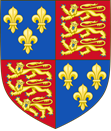






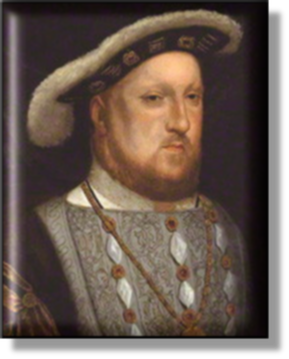 xxxxx
xxxxx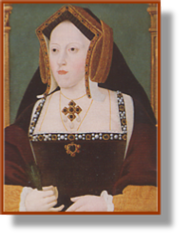 xxxxx
xxxxx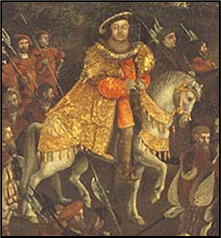 xxxxx
xxxxx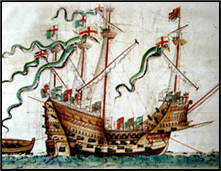 xxxxx
xxxxx one
of the greatest artists of the High Renaissance, completes
his famous frescoes on the ceiling of the Sistine Chapel in
Rome.
one
of the greatest artists of the High Renaissance, completes
his famous frescoes on the ceiling of the Sistine Chapel in
Rome. 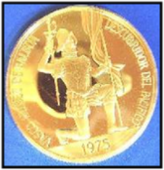 painter
and graphic artist of this period, completes his
painter
and graphic artist of this period, completes his 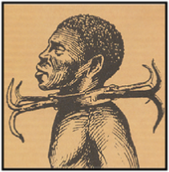 Slave Trade begins in earnest.
Slave Trade begins in earnest.  the
Portuguese navigator
the
Portuguese navigator  Following
a three-
Following
a three-
 Jesus,
known as the
Jesus,
known as the  eavenly
Bodies
eavenly
Bodies